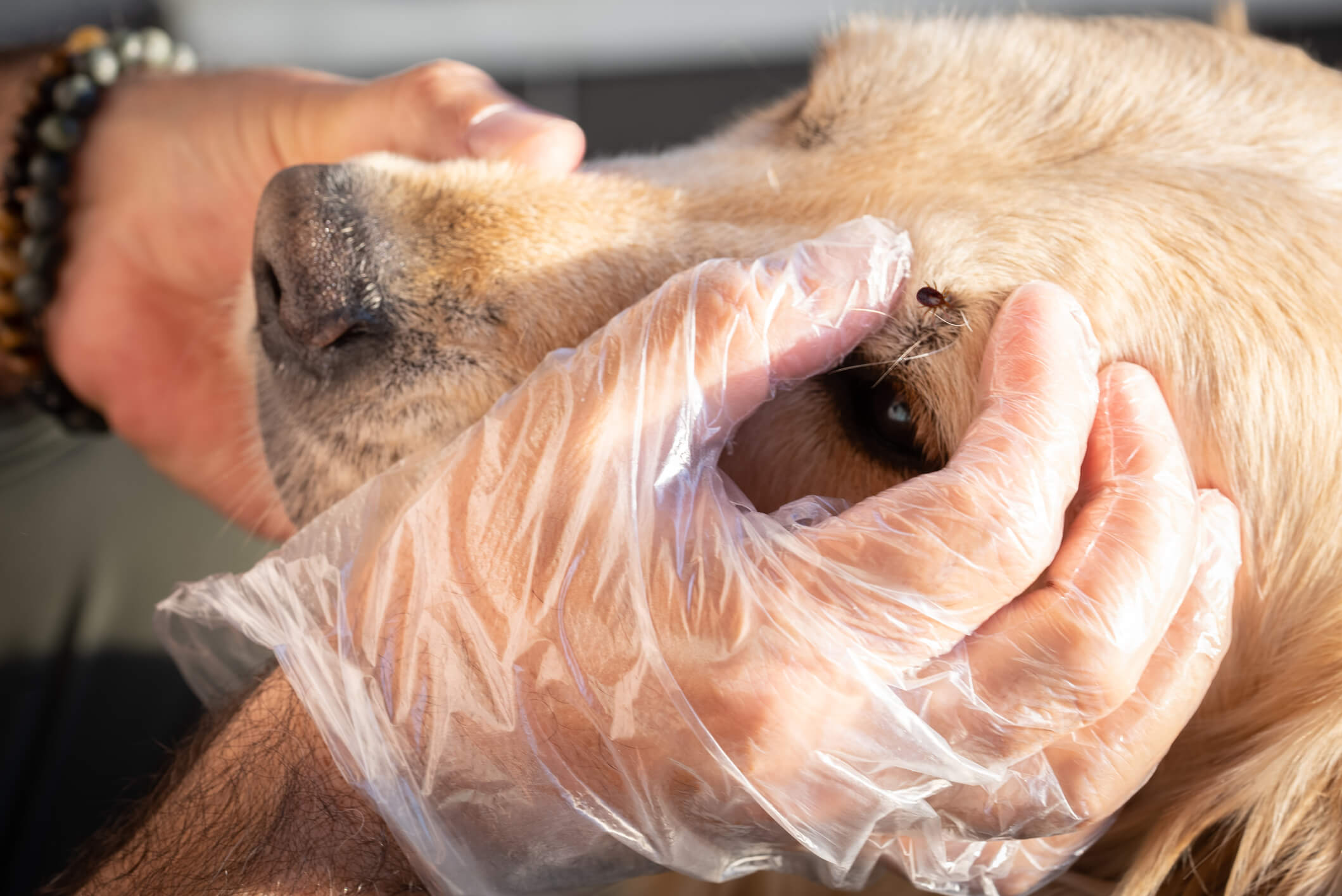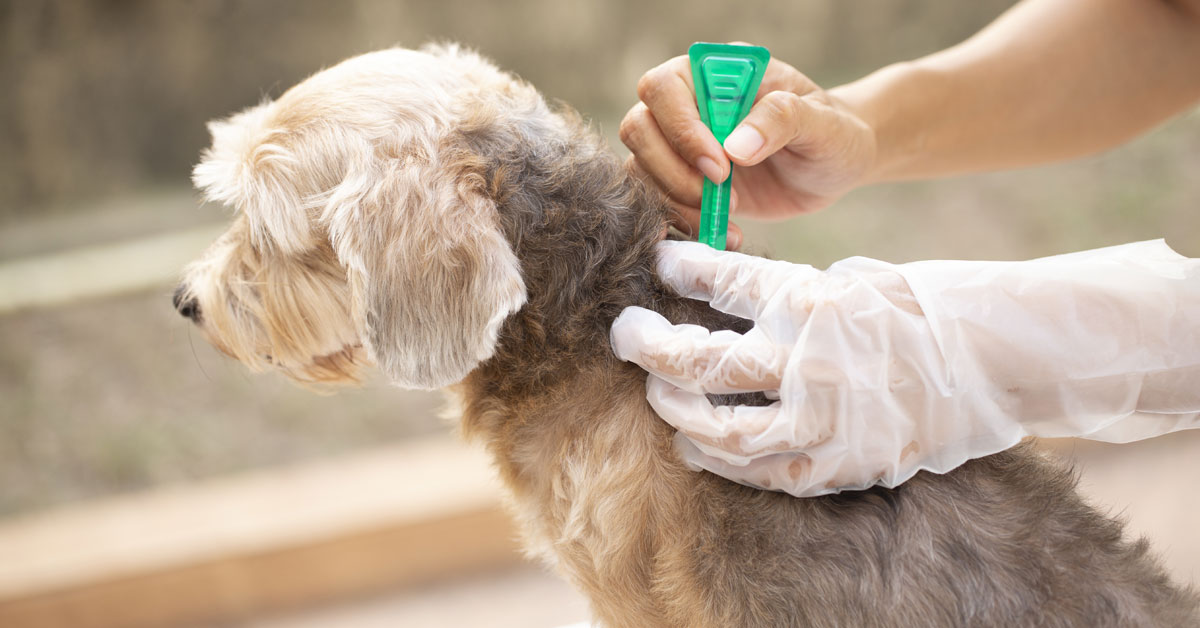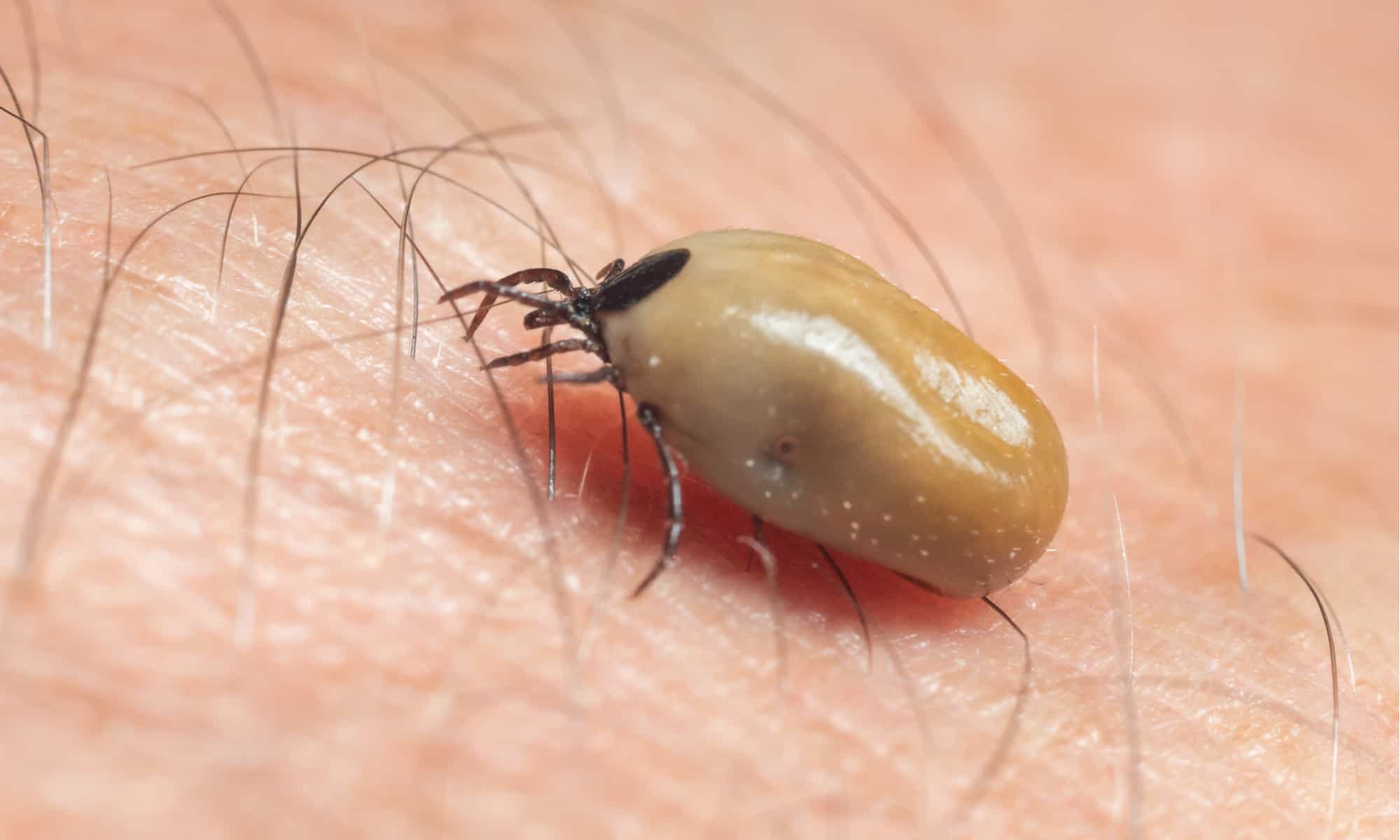Home>Health & Wellness>Common Health Issues>How To Kill Ticks On Dogs


Common Health Issues
How To Kill Ticks On Dogs
Published: February 5, 2024
Learn effective ways to kill ticks on dogs and prevent common health issues. Keep your furry friend healthy and happy with these tips.
(Many of the links in this article redirect to a specific reviewed product. Your purchase of these products through affiliate links helps to generate commission for Pawsomeoldies.com, at no extra cost. Learn more)
Table of Contents
Introduction
Ticks are tiny, blood-sucking parasites that can pose a significant threat to the health and well-being of our canine companions. These pesky creatures are not only a nuisance but also carriers of various diseases that can cause serious health issues for dogs. As a responsible pet owner, it's crucial to understand the risks associated with tick infestations and take proactive measures to protect our furry friends.
In this comprehensive guide, we will delve into the world of ticks and explore the dangers they present to dogs. We will discuss the signs of tick infestations in dogs, effective methods for removing ticks, and crucial strategies for preventing future infestations. By gaining a deeper understanding of these bloodthirsty parasites and learning how to combat them, you can safeguard your canine companion from potential harm and ensure their continued well-being.
Throughout this article, we will provide valuable insights and practical tips to empower you as a pet owner. From identifying the signs of tick infestations to implementing preventive measures, we will equip you with the knowledge and tools necessary to keep your dog safe from these troublesome pests. So, let's embark on this journey together and learn how to protect our beloved four-legged friends from the perils of tick infestations.
Read more: How To Naturally Kill Ticks On Dogs
Understanding Ticks and Their Dangers
Ticks are small, blood-feeding parasites that belong to the arachnid family. These resilient creatures thrive in diverse environments, including grassy areas, wooded regions, and even urban landscapes. Ticks are notorious for latching onto hosts, such as dogs, and feeding on their blood to sustain their life cycle. While the act of feeding itself can cause discomfort to dogs, the dangers posed by ticks extend far beyond mere irritation.
One of the most significant threats associated with ticks is their ability to transmit a variety of diseases to their hosts. These diseases can have serious implications for the health of dogs, ranging from mild symptoms to severe, life-threatening conditions. Some of the most common tick-borne diseases include Lyme disease, ehrlichiosis, anaplasmosis, and Rocky Mountain spotted fever. Each of these diseases can manifest with its own set of symptoms, such as fever, lethargy, joint pain, and in severe cases, organ damage.
Furthermore, ticks are adept at concealing themselves on a dog's body, making them difficult to detect. They often gravitate towards hidden areas, such as the ears, between the toes, and under the tail, where they can latch on and feed unnoticed. This stealthy behavior allows ticks to remain undetected for extended periods, increasing the risk of disease transmission and exacerbating the health hazards they pose to dogs.
In addition to the direct health risks they present, ticks can also cause secondary complications. When a tick attaches itself to a dog and begins feeding, it can introduce toxins into the dog's bloodstream, leading to allergic reactions and skin irritations. Moreover, the physical act of a tick feeding can result in localized inflammation and discomfort at the bite site, potentially leading to skin infections and other dermatological issues.
Understanding the dangers associated with ticks is paramount for pet owners, as it underscores the importance of proactive tick prevention and prompt removal. By recognizing the potential threats posed by these tiny parasites, pet owners can take informed steps to protect their dogs from the perils of tick-borne diseases and minimize the risk of infestations.
Signs of Tick Infestation in Dogs
Detecting a tick infestation in dogs requires keen observation and a thorough understanding of the telltale signs that may indicate the presence of these bloodthirsty parasites. While ticks are adept at concealing themselves on a dog's body, several indicators can alert pet owners to a potential infestation. By recognizing these signs early on, pet owners can take swift action to address the issue and mitigate the risks associated with tick-borne diseases.
1. Visible Presence of Ticks:
One of the most obvious signs of a tick infestation is the visual identification of ticks on the dog's body. Ticks can vary in size, ranging from as small as a pinhead to as large as a pea, and may appear as dark, raised bumps on the skin. It's essential to conduct regular visual inspections of your dog's coat, paying close attention to areas where ticks are known to hide, such as the ears, groin, armpits, and between the toes.
2. Excessive Scratching or Licking:
Tick bites can cause irritation and discomfort for dogs, leading to increased scratching or licking of the affected areas. If you notice your dog exhibiting persistent scratching or excessive grooming behavior, it may indicate the presence of ticks. Additionally, dogs may display signs of agitation or restlessness as a result of the discomfort caused by tick bites.
3. Skin Irritation and Redness:
When ticks attach themselves to a dog's skin and begin feeding, they can induce localized irritation and redness at the bite sites. These areas may appear inflamed and tender to the touch. Pet owners should carefully inspect their dog's skin for any signs of redness, swelling, or unusual bumps, as these could be indicative of tick bites.
4. Lethargy and Loss of Appetite:
In some cases, tick infestations can lead to systemic effects on a dog's health, causing symptoms such as lethargy, decreased activity, and loss of appetite. If your dog displays unexplained fatigue or a sudden disinterest in food, it may warrant a closer examination for potential tick-related issues.
5. Fever and Joint Pain:
Certain tick-borne diseases, such as Lyme disease, can manifest with symptoms including fever, lameness, and joint pain in affected dogs. These systemic signs may indicate the presence of a tick-borne illness and should prompt immediate veterinary attention.
By remaining vigilant and attuned to these signs, pet owners can promptly identify and address tick infestations in their dogs, thereby safeguarding their beloved pets from the perils of tick-borne diseases. Regular grooming, thorough inspections, and proactive preventive measures are essential components of effective tick management for dogs.
Methods for Removing Ticks from Dogs
When it comes to removing ticks from dogs, it's essential to approach the process with care and precision to ensure the complete extraction of these persistent parasites. Prompt and thorough tick removal is crucial in minimizing the risk of disease transmission and preventing potential complications for the affected dog. Here are several effective methods for safely removing ticks from dogs:
Read more: How To Kill Fleas On Dog’s Butt
1. Fine-Tipped Tweezers:
Using fine-tipped tweezers is a widely recommended method for removing ticks from a dog's skin. To do so, grasp the tick as close to the skin's surface as possible and steadily pull upward with a gentle, even pressure. It's important to avoid twisting or jerking the tick, as this can cause the mouthparts to break off and remain embedded in the skin. Slow and steady traction should be applied until the tick releases its hold, allowing for complete removal.
2. Tick Removal Tools:
Specialized tick removal tools, such as tick hooks or tick twisters, are designed to facilitate the safe and efficient removal of ticks from a dog's skin. These tools work by gently levering the tick away from the skin, minimizing the risk of leaving behind mouthparts. When using a tick removal tool, it's crucial to follow the manufacturer's instructions carefully to ensure proper technique and successful tick extraction.
3. Tick Removal Gloves:
Some pet owners opt to use tick removal gloves, which are equipped with textured surfaces that aid in gripping and removing ticks from a dog's coat. These gloves provide a hands-on approach to tick removal and can be particularly useful for dogs with thick or long fur. By running the gloves over the dog's body and focusing on areas where ticks are likely to hide, pet owners can effectively dislodge and remove ticks from the dog's coat.
4. Veterinary Assistance:
In cases where pet owners are uncomfortable or uncertain about removing ticks from their dogs, seeking veterinary assistance is advisable. Veterinarians possess the expertise and specialized tools to safely and effectively remove ticks from dogs, ensuring thorough extraction and minimizing the risk of complications. Additionally, veterinarians can offer guidance on tick prevention and recommend suitable preventive products for ongoing protection.
5. Avoid Home Remedies:
It's important to note that certain home remedies, such as using heat sources or applying substances like petroleum jelly or nail polish, are not recommended for tick removal. These methods can agitate the tick, leading to regurgitation and potential disease transmission. Therefore, it's best to rely on proven tick removal techniques and exercise caution to prevent inadvertently exacerbating the situation.
By employing these methods for removing ticks from dogs and exercising diligence in the extraction process, pet owners can effectively safeguard their canine companions from the risks associated with tick infestations. Following tick removal, it's crucial to monitor the dog for any signs of infection or adverse reactions and seek veterinary attention if concerns arise. Regular tick checks and preventive measures are essential components of responsible pet ownership, ensuring the well-being and health of our beloved four-legged friends.
Preventing Tick Infestations in Dogs
Preventing tick infestations in dogs is a proactive and essential aspect of responsible pet care. By implementing effective preventive measures, pet owners can significantly reduce the risk of tick-borne diseases and safeguard their canine companions from the perils of tick infestations. Here are several strategies to prevent tick infestations in dogs:
-
Regular Tick Checks: Conducting thorough tick checks on a routine basis is paramount for early detection and prompt removal of ticks. After outdoor activities or walks in areas where ticks are prevalent, carefully inspect your dog's coat, paying close attention to hidden areas such as the ears, groin, and between the toes. By promptly identifying and removing any ticks, pet owners can mitigate the risk of infestations and disease transmission.
-
Tick Preventive Products: Utilizing veterinarian-recommended tick preventive products, such as spot-on treatments, oral medications, or tick collars, can provide an additional layer of defense against tick infestations. These products are designed to repel ticks or eliminate them upon contact, effectively reducing the likelihood of ticks latching onto dogs and establishing infestations.
-
Environmental Management: Maintaining a well-groomed and tick-resistant environment can help minimize the risk of tick infestations. Regularly mowing the lawn, trimming overgrown vegetation, and removing leaf litter can create an inhospitable environment for ticks, reducing their presence in outdoor spaces frequented by dogs.
-
Tick-Proofing Living Spaces: Implementing measures to tick-proof living spaces, such as using tick-resistant bedding and regularly vacuuming and cleaning indoor areas, can help minimize the risk of ticks establishing themselves in the home environment. By creating a tick-unfriendly living space, pet owners can reduce the likelihood of infestations and protect their dogs from potential exposure to ticks indoors.
-
Educational Awareness: Educating oneself about the prevalence of ticks in specific geographic regions and the seasonal variations in tick activity is crucial for implementing targeted preventive measures. By staying informed about local tick populations and their associated risks, pet owners can tailor their preventive strategies to effectively combat tick infestations.
-
Professional Guidance: Seeking guidance from veterinarians regarding the selection of appropriate tick preventive products and vaccination against tick-borne diseases can provide valuable insights for pet owners. Veterinarians can offer personalized recommendations based on the specific needs and risk factors associated with individual dogs, empowering pet owners to make informed decisions about tick prevention.
By integrating these preventive strategies into a comprehensive tick management plan, pet owners can take proactive steps to protect their dogs from the dangers of tick infestations. By remaining vigilant, proactive, and well-informed, pet owners can create a safe and tick-resistant environment for their beloved canine companions, ensuring their continued health and well-being.
Conclusion
In conclusion, safeguarding our canine companions from the perils of tick infestations is a fundamental responsibility for pet owners. Ticks pose significant health risks to dogs, ranging from discomfort and irritation to the transmission of serious, potentially life-threatening diseases. By understanding the dangers associated with ticks and recognizing the signs of infestations, pet owners can take proactive measures to protect their beloved pets.
Effective tick management encompasses a multi-faceted approach, including regular tick checks, prompt tick removal, and the implementation of preventive measures. By conducting thorough tick inspections, utilizing veterinarian-recommended tick preventive products, and maintaining tick-resistant living spaces, pet owners can significantly reduce the risk of tick infestations and mitigate the potential health hazards posed by these resilient parasites.
Furthermore, the importance of education and awareness cannot be overstated. By staying informed about local tick populations, seasonal variations in tick activity, and the prevalence of tick-borne diseases, pet owners can tailor their preventive strategies to suit specific geographic regions and environmental factors. Seeking professional guidance from veterinarians and remaining proactive in tick prevention efforts are essential components of responsible pet care.
Ultimately, the well-being and health of our canine companions depend on our commitment to mitigating the risks associated with tick infestations. By integrating comprehensive tick management practices into our pet care routines, we can create a safe and tick-resistant environment for our dogs, ensuring their continued health and vitality.
As responsible pet owners, it is our duty to prioritize the welfare of our four-legged friends and take proactive steps to protect them from the dangers of tick infestations. Through vigilance, education, and proactive preventive measures, we can provide our dogs with a safe and nurturing environment, free from the perils of tick-borne diseases. Let us embark on this journey with dedication and compassion, ensuring that our beloved canine companions lead healthy, tick-free lives.












